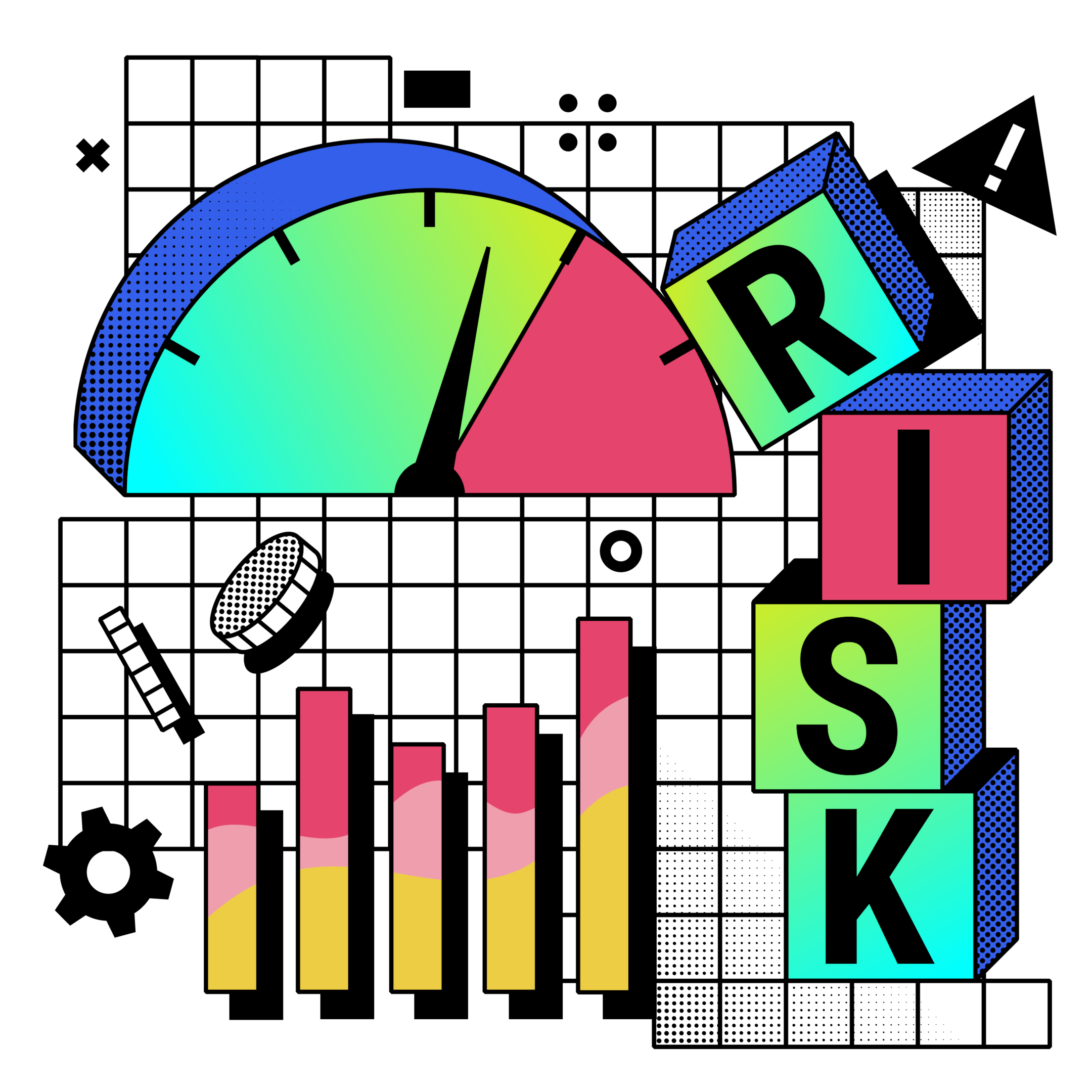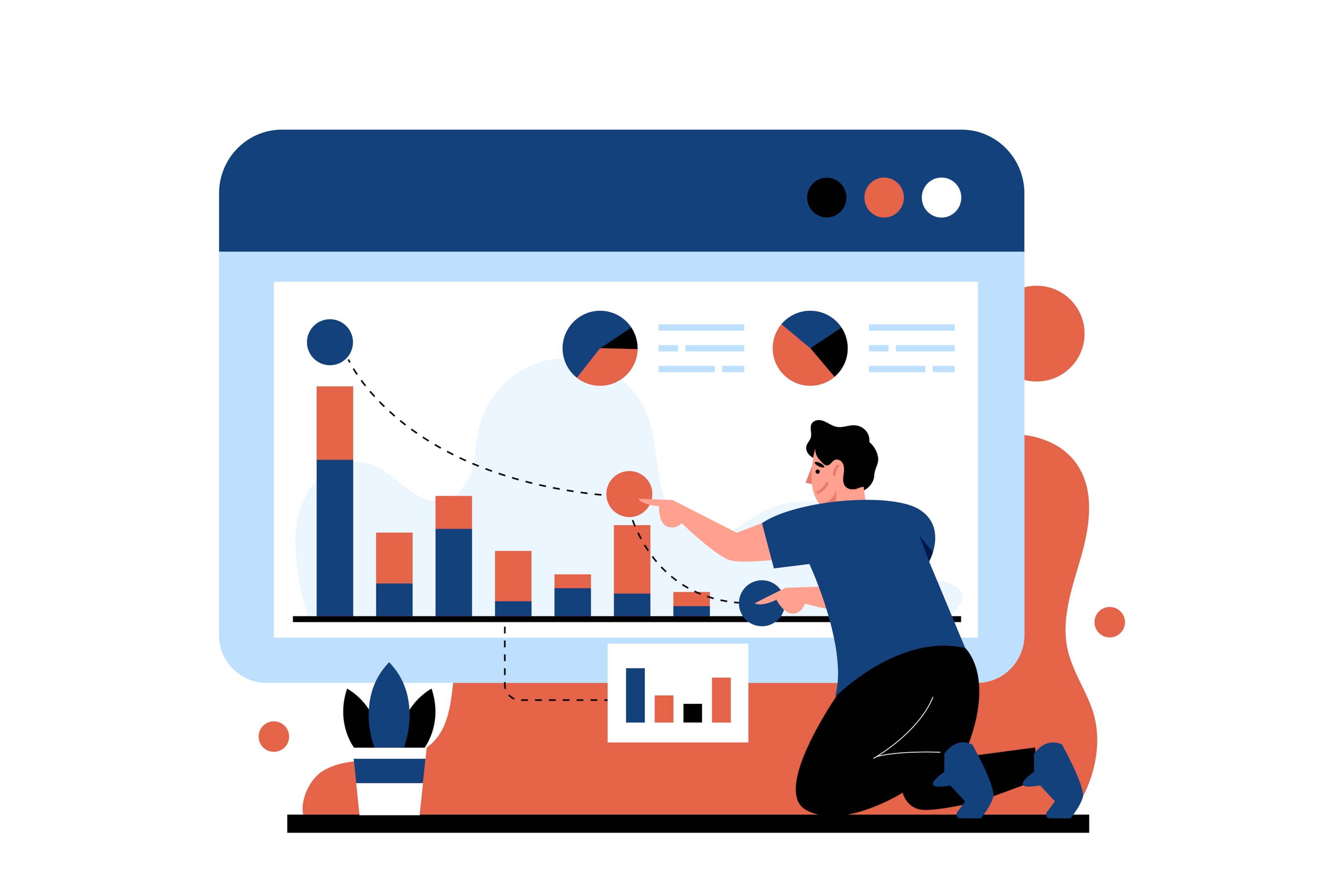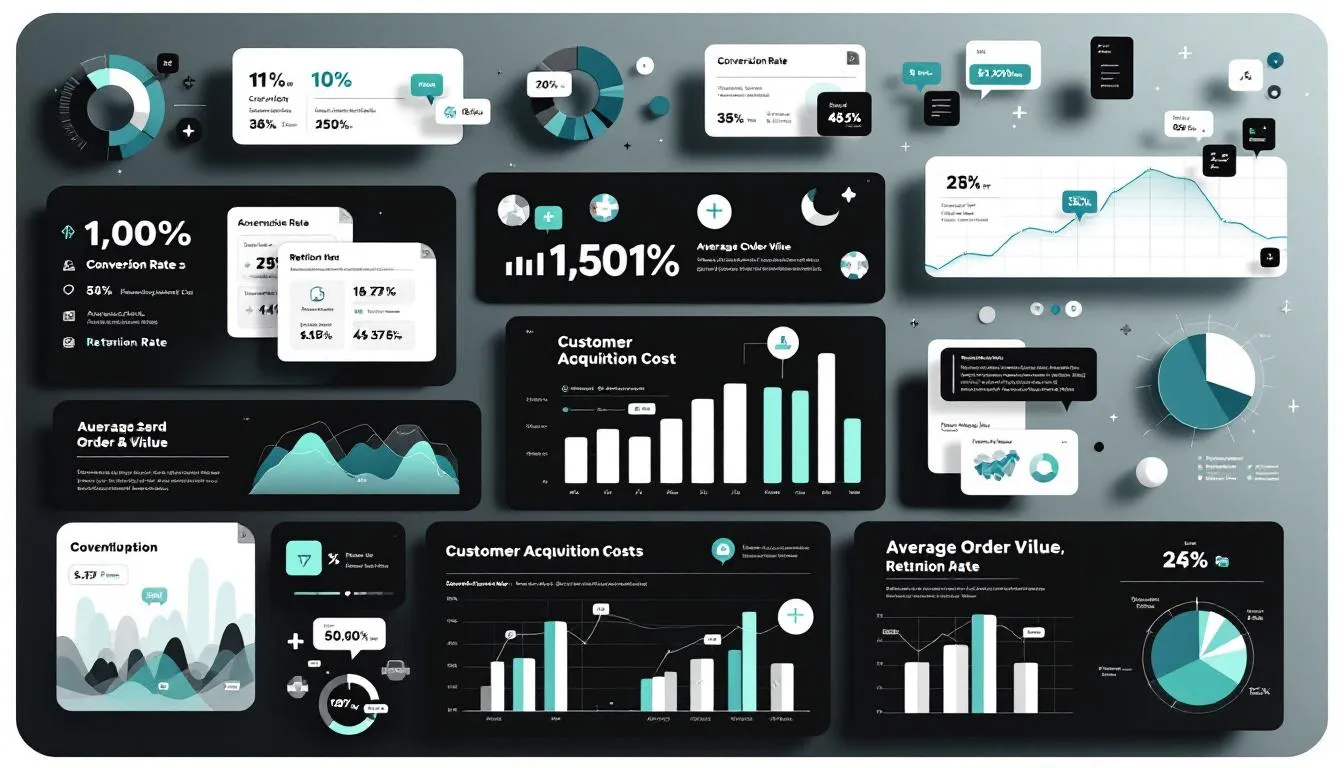The ecommerce landscape isn’t just crowded – it’s competitive, fast-paced, and data-driven. Success no longer depends solely on a great product or flashy ads; it hinges on your ability to track, understand, and respond to performance metrics. In 2025, businesses that thrive are those that know their numbers – inside and out. This guide breaks down the most essential ecommerce metrics and KPIs in the warehouse operations and the supply chain, helping you identify what to track, why it matters, and how it can drive smarter strategies and faster growth.
Key Takeaways
- Ecommerce metrics are essential for assessing online performance and informing business strategies, helping align metrics with business goals.
- Key metrics like conversion rate, average order value, and customer acquisition cost provide insights into sales effectiveness and marketing efficiency.
- Tracking customer engagement and retention metrics, such as customer retention rate and net promoter score, is crucial for building loyalty and driving long-term success.
Understanding Ecommerce Metrics and KPIs

Ecommerce metrics and key performance indicators (KPIs) are the backbone of any successful ecommerce business. They are quantifiable measurements that help businesses evaluate their online performance and success, guiding decision-making and strategy development.
Whether it’s tracking website traffic, bounce rates, or customer acquisition costs, these ecommerce key performance indicators, ecommerce kpi, and e commerce kpis provide important insights into various aspects of business performance.
Selecting ecommerce metrics should align with your main business goals and objectives, ensuring the metrics tracked are relevant and provide actionable insights. Understanding the difference between ecommerce metrics and KPIs helps measure both processes and their outcomes effectively.
What are ecommerce metrics?
Ecommerce metrics are quantifiable data points that reflect various aspects of a business’s performance. They are essential for evaluating the effectiveness of marketing efforts, understanding customer behavior, and optimizing overall business performance. Common examples of ecommerce metrics are:
- Conversion rate
- Average order value
- Ecommerce metric Other important metrics include:
- Cart abandonment rate
- Traffic sources.
These metrics offer a detailed view of business performance, enabling informed decisions and strategy adjustments. Utilizing ecommerce metrics helps businesses track success, inform strategy, and optimize performance.
What are key performance indicators (KPIs)?

Key performance indicators (KPIs) are specific, measurable milestones that help track the performance and success of a business. A key performance indicator is directly tied to business goals and objectives, offering a clear picture of progress and performance. They measure process efficiency and effectiveness, aiding in strategic decision-making and goal setting.
The main difference between a metric and a KPI is that while metrics measure processes, KPIs measure the performance of those processes. KPIs can be:
- Qualitative
- Quantitative
- Predictive
- Historical These types offer a comprehensive view of business performance.
Why are ecommerce KPIs important?
Ecommerce KPIs are essential for evaluating the effectiveness of business processes and guiding strategic decisions. They serve as benchmarks for success, helping businesses gauge progress and make informed decisions. Tracking KPIs helps businesses understand inventory needs, enhance customer loyalty, and improve profitability.
By providing actionable insights, KPIs help ecommerce businesses identify how well they attract visitors and convert them into buyers. This, in turn, leads to better strategic planning, goal setting, and overall business performance.
Key Ecommerce Metrics to Track

Monitoring key ecommerce metrics is crucial for understanding business performance in sales, service, marketing, and operations. These metrics provide insightful, actionable information that can significantly impact your business’s success.
Regularly tracking these metrics enables informed decision-making, strategy adjustments, and valuable insight into data-driven growth.
Website traffic
Website traffic is a fundamental metric that measures the number of user visits to your ecommerce site. It helps assess brand awareness and the effectiveness of your marketing. Analyzing both organic search and paid traffic sources provides insights into how much traffic visitors find your site and which marketing strategies are most effective.
If you’re targeting international audiences, especially Europe, understanding regional specifics like German market entry can help improve your site’s traffic strategies in new markets.
Bounce rate
Bounce rate measures the percentage of visitors who leave your site after viewing only one page. It is a critical indicator of user engagement and website effectiveness. To find the bounce rate, divide the number of single-page visits by the total number of visits.
A high bounce rate often indicates issues with site content, user experience, or landing page relevance. Addressing these issues can improve engagement, reduce bounce rates, and increase conversion rates.
Average order value (AOV)
Average Order Value (AOV) is a crucial metric that helps businesses understand how much customers typically spend per order, including the average purchase value and the average value. Calculated by dividing total revenue by the number of orders, monitoring AOV aids in making informed decisions about pricing, marketing, and product strategies.
Strategic upselling, cross-selling or bundling can be particularly effective in niches like sell supplements or sell vitamins where customers may be willing to buy in bulk. These tactics encourage customers to spend more per transaction, boosting overall revenue.
Customer acquisition cost (CAC)
Customer acquisition cost (CAC) measures the total cost of acquiring a new customer, divided by the number of customers acquired. It is a vital metric for understanding the efficiency of your marketing and sales efforts. A low CAC is essential for maintaining profitability.
To optimize CAC, it’s important to evaluate fulfillment costs too – whether you’re using fulfilled by TikTok or another channel.
Essential Ecommerce Key Performance Indicators

Tracking essential KPIs is vital for driving business success. These KPIs offer a clear picture of business performance, aiding in informed decision-making and goal alignment.
Regularly monitoring these KPIs ensures continual improvement and data-driven growth.
Conversion rate
The conversion rate is a critical KPI that measures the percentage of website visitors who make a purchase. It indicates how well your site converts visitors into buyers, and thus impacts the marketing campaigns. To calculate the conversion rate, you need to divide the total number of sales. This figure is then compared to the total number of visitors.
Factors influencing conversion rates include website design, product descriptions, and calls-to-action. To improve it, consider the full supply chain experience – from first mile delivery to last mile delivery tracking – since smooth logistics drive customer trust and conversions.
Customer lifetime value (CLV)
Customer lifetime value (CLV) estimates the total revenue a business can expect from a customer throughout their relationship. It is a crucial metric for understanding customer satisfaction, loyalty, and overall business viability.
To calculate Customer Lifetime Value (CLV), divide the total revenue generated by a customer by the number of days they have been a customer. Maximize CLV with tailored marketing, customized offers, and loyalty programs.
Tools like personalized subscriptions and distribution management help increase retention and overall CLV.
Shopping cart abandonment rate
The shopping cart abandonment rate indicates how many shoppers add items to their cart. However, it also reflects the percentage of those who do not complete the purchase. A high abandonment rate indicates potential barriers in the checkout process.
Reducing cart abandonment can improve user experience and increase revenue. Strategies include simplifying the checkout process, offering multiple payment options, and providing clear shipping costs information.
Repeat purchase rate (RPR)
Repeat purchase rate measures the percentage of customers making a second purchase, reflecting user loyalty and satisfaction. It is calculated by dividing the purchases from repeat customers by the total purchases.
A high RPR indicates that people are satisfied with their first purchase and are likely to return for as repeat customers. Tracking purchase frequency helps measure the success of marketing campaigns and changes in customer behavior.
Customer Engagement and Retention Metrics

Customer engagement and retention metrics are crucial for long-term success in ecommerce. They provide insights into how well you retain customers and how engaged they are with your brand.
Prioritizing customer experience leads to higher rates of repeat purchases and overall business growth.
Customer retention rate
Customer retention rate measures the percentage of customers maintained over time. A high retention rate indicates a healthy business where customers enjoy the products and services. It is calculated by subtracting new customers from end customers and dividing by start customers.
Good customer service, loyalty programs, and investments in customers benefit retention. Keeping customers coming back is more cost-effective than acquiring new ones, making this metric vital for profitability. Ensuring reliability through practices like cargo insurance and consistent delivery times can positively impact retention rates.
Net promoter score (NPS)
Net Promoter Score (NPS) gauges how likely customers are to recommend your business. It assesses the likelihood of referrals from your customer base. It categorizes customers into promoters, passives, and detractors based on their likelihood to recommend your business.
NPS is a valuable metric for understanding customer loyalty and the effectiveness of your customer care efforts. High NPS indicates strong customer support and advocacy.
Customer satisfaction
Measuring customer happiness levels is crucial for understanding customer needs and improving the overall customer experience. Using surveys and feedback forms helps gather useful insights into customer satisfaction and identify areas for improvement. Customer feedback enables businesses to make informed decisions that enhance the customer experience, leading to higher satisfaction and loyalty.
Tools and Techniques for Tracking Ecommerce Metrics and KPIs

Effective tracking of ecommerce metrics requires a combination of analytical tools, data visualization techniques, and benchmarking practices. Regularly assessing key performance indicators helps e commerce businesses pinpoint strengths and identify areas needing enhancement.
Analytic tools
Google Analytics, Shopify’s built-in analytics tools, and various B2B ecommerce software are popular for tracking KPIs, offering insights into popular products, profitable pages, and checkout percentages.
The GA4 update in Google Analytics offers simpler usage and more accurate data identification, making it easier to track marketing KPIs effectively.
Data visualization
Data visualization is crucial for interpreting complex ecommerce metrics and making informed business decisions. Visualizing data simplifies the interpretation process, making it more accessible for stakeholders to understand performance metrics.
Looker Studio is a powerful tool used in ecommerce for data visualization and customizable reporting, facilitating better decision-making.
Benchmarking
Benchmarking against industry standards helps e commerce businesses assess their performance relative to competitors and identify improvement opportunities. It involves systematic steps, from competitor identification to data collection and performance analysis.
Choosing the right analytic tools is crucial for accurately collecting and interpreting ecommerce data. This process helps businesses gain insights into areas where they can improve and stay competitive in the market.
Strategies to Improve Ecommerce KPIs

Improving ecommerce KPIs requires strategic efforts and innovative approaches. Leading ecommerce websites often invest in emerging technologies and data-driven decision-making to enhance overall performance on their ecommerce website.
By adopting these strategies, businesses can optimize their KPIs and achieve better results.
- Optimize conversion rates: Enhancing website usability can significantly improve user experience and lead to higher conversion rates. Streamlining online store checkout process reduces cart abandonment and increases sales. Identifying and reducing friction points in the customer journey creates a smoother shopping experience, boosting conversion rates and driving more sales.
- Enhance customer experience: Focusing on retaining existing customers is more cost-effective and yields a higher return on investment than acquiring new ones. Implementing loyalty initiatives and improving customer service can significantly enhance customer support and retention rates. Exceptional customer service and personalized experiences are key strategies for improving satisfaction and fostering long-term loyalty, supported by our dedicated customer service team.
- Increase average order value: Increasing average order value involves selling add-ons, implementing loyalty programs, and adjusting pricing. Upselling, bundle deals, and product recommendations effectively enhance AOV. Implementing these strategies can significantly boost overall sales and enhance customer support, leading to higher revenue growth.
Lessons from Successful Ecommerce Brands
Studying top ecommerce brands provides valuable dos and don’ts in the industry that can significantly enhance brand performance. Successful ecommerce brands often emphasize brand storytelling to connect emotionally with consumers and drive engagement.
Prioritize customer experience
Zappos is renowned for its exceptional customer service, often going above and beyond to satisfy customers. Their customer-centric approach, including hassle-free returns and 24/7 support, fosters customer loyalty and drives growth.
A customer-centric approach is crucial for brands aiming to foster loyalty and drive growth. Prioritizing customer experience can lead to higher retention rates and overall business success.
Leverage social media

Top ecommerce brands and online stores use social media to create engaging content that fosters interaction and loyalty. Brands like Glossier effectively build community engagement and gather customer feedback through social media.
Brands like ASOS use high-quality visuals and interactive content on social media to enhance engagement and drive sales. Leveraging social media effectively can lead to increased brand loyalty and higher sales.
Embrace innovation
Businesses and online stores must continually adapt to changing consumer preferences, market conditions, and competitive pressures to stay relevant. Implementing flexible business models and utilizing advanced analytics and AI technologies can significantly enhance an ecommerce business’s ability to personalize offers and predict trends.
Embracing automation tools helps streamline operations, improve customer service, and optimize logistics in e commerce businesses and online stores. Successful ecommerce brands leverage adaptability and technological advancements to enhance customer experience and build loyalty.
Summary
Tracking and improving ecommerce metrics and KPIs is more than just a numbers game – it’s the foundation of strategic growth and customer-centric success. By focusing on key indicators like conversion rate, customer lifetime value, and retention rate, online stores and e commerce businesses can make smarter decisions, refine user experiences, and boost long-term profitability. As the ecommerce landscape continues to evolve in 2025, staying data-driven ensures your brand remains agile, competitive, and aligned with ever-changing customer expectations.
Frequently Asked Questions
What are ecommerce metrics?
Ecommerce metrics are key data points that show how well your online business is doing, covering areas like sales and customer behavior. They’re essential for understanding performance and making informed decisions.
What is the difference between a metric and a KPI?
A metric is all about measuring processes, but a KPI focuses on the performance of those processes while aligning with your business goals. Simply put, KPIs are the key indicators that show how well you’re doing compared to your objectives.
How can I reduce my shopping cart abandonment rate?
To effectively reduce your shopping cart abandonment rate, streamline the checkout process and offer various payment options while providing clear shipping information. Making these adjustments can greatly enhance the user experience and encourage more completed purchases.
What tools can I use to track e commerce KPIs and metrics?
To effectively track both, you can use Google Analytics, Shopify’s built-in analytics, and various B2B ecommerce software. These tools will help you uncover insights about your sales performance and customer behavior.



 Community
Community
